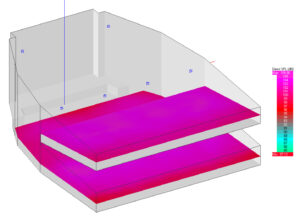Designing a sound system for an auditorium space is a complex task that requires an expert blend of engineering and design to ensure an immersive and enjoyable audience experience in which every word, note, and sound effect is heard with clarity and precision. When designing pro-grade systems, PureTek audio engineers consider many factors including:

The location and position of line arrays as well as the individual speaker selection, angle, and power are carefully considered per auditorium.
Acoustics
The acoustic properties of the space play a crucial role in sound system design. The size, shape, and materials of the auditorium such as the flooring, wall treatments, and even audience size affect sound reflections, echoes, and overall clarity. Acoustic treatments like sound dampening panels are strategically placed to enhance sound quality and prevent unwanted resonances.
Venue Size and Design
The size of the venue determines the sound system’s power requirements and speaker placement where larger venues generally require more powerful amplifiers and larger speakers to ensure sufficient sound coverage and volume. PureTek audio engineers spend a significant amount of time on-site taking detailed site and audio measurements to ensure a system that is neither underpowered and underdelivers nor is overly powerful and overly expensive.
Speaker Placement
The arrangement of speakers is critical to achieve even sound distribution. The system designer must consider factors such as speaker type, coverage angles, and positioning to ensure optimal sound dispersion throughout the venue, including balconies and other challenging areas. Powerful audio modeling software is used to create detailed acoustical calculations to ensure properly distributed sound.

In-depth calculations for spaces with complex geometries and uneven distribution of sound absorbtion are conducted.
Sound Reinforcement
In addition to natural acoustics, sound reinforcement systems are used to amplify and enhance sound. This involves adding smaller speakers in areas where sound may be under-delivered or potentially warped such as under balconies. In these areas, audio from the main and support speakers is expertly calibrated by PureTek engineers on-site using fine-tuned sensors with audio mixing consoles and signal processing equipment.
Flexibility
Auditoriums host a variety of events, from music concerts to lectures to film festivals to theatrical performances. A sound system design should be versatile enough to accommodate different types of productions and adapt to the specific requirements of various outputs. Systems must have enough power to account for the deep bass of a guest DJ or to drive forward the mid-range for a TED Talk. Furthermore, PureTek provides comprehensive staff and student audio mixing console training to empower them to provide the fine-tuned corrections needed to deliver excellent sound quality regardless of the need.

Powerful audio modeling software considers the unique properties of an auditorium to aid in the design of systems with crisp and even sound distribution.
Accessibility
Considerations for individuals with hearing impairments are crucial. Installing assistive listening devices ensures that everyone can enjoy the performance regardless of their hearing abilities.
Maintenance and Future Expansion
A well-designed sound system simplifies maintenance needs, allows for various audio inputs from microphones to instruments, and readily accommodates future temporary or permanent system expansions or upgrades. Accessibility for maintenance, scalability, and compatibility with emerging technologies must always be considered.
Designing a sound system for an auditorium is a multidimensional task that requires expertise in acoustics, audio engineering, and venue specifications. By considering these factors and working closely with clients to fulfill the unique needs of every University or School District, our audio engineering team designs systems that deliver exceptional sound quality and an immersive experience for the audience.

